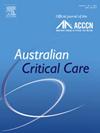Predicting intensive care unit–acquired weakness in the first week of an intensive care unit stay: A multicentre external validation study
IF 2.7
3区 医学
Q2 CRITICAL CARE MEDICINE
引用次数: 0
Abstract
Background
To diagnose intensive care unit–acquired weakness (ICU-AW) in a timely manner, we previously constructed a prediction model based on multicentre data from 642 patients (development cohort), focussing on the presence of ICU-AW on days 3–5 of ICU admission.
Objective
The aim of this study was to investigate the external validity of the original prediction model in a new multicentre cohort (10 of the 80 original ICUs) and investigate frailty as a new predictor.
Methods
Newly admitted patients with an ICU stay for >48 h were included. Predictors were prospectively recorded, and an outcome of ICU-AW was defined by a Medical Research Council (MRC) mean score <48. We assessed calibration and discrimination in the original prediction model in the validation cohort (411 patients). We then updated the model in the validation cohort by adding frailty, measured using FRAIL-España and the Clinical Frailty Scale-España.
Results
Of the 351 patients with an MRC score in the validation cohort, 195 (55.5%) developed ICU-AW. Model calibration and discrimination in the original model were good with these patients (calibration-in-the-large was 0.17 [95% confidence interval {CI}: {-0.07; 0.40}], slope was 0.93 [95% CI: {0.66; 1.21}], and area under the receiver operating characteristic curve was 0.723 [95% CI: {0.67; 0.78}]. However, when the model validation included unconscious patients (unfeasible for MRC score assessment) classified as having ICU-AW, there was a tendency to underestimate ICU-AW. Model updating did not improve performance (net reclassification improvement was −0.2% with Clinical Frailty Scale-España and −0.3% with FRAIL-España.
Conclusions
The initial prediction model for ICU-AW shows good performance in this new independent multicentre validation cohort, which confirms that the predictor variables of ICU-AW for the first 5 days of ICU stay are older age, being female, not being conscious for MRC assessment, and receiving renal replacement therapy. Protectors are active mobility and hyperactive delirium. The frailty variable does not enhance the predictive model.
预测重症监护病房入住第一周的重症监护病房获得性虚弱:一项多中心外部验证研究
为了及时诊断重症监护病房获得性虚弱(ICU- aw),我们先前基于642例患者(发展队列)的多中心数据构建了一个预测模型,重点关注ICU入院第3-5天是否存在ICU- aw。目的本研究的目的是在一个新的多中心队列(80个原始icu中的10个)中研究原始预测模型的外部有效性,并研究虚弱作为一个新的预测因素。方法选取ICU住院时间为48 h的新住院患者。前瞻性地记录预测因素,并根据医学研究委员会(MRC)的平均评分[lt;48]定义ICU-AW的结果。我们在验证队列(411例患者)中评估了原始预测模型的校准和区分。然后,我们更新了验证队列中的模型,增加了脆弱性,使用FRAIL-España和临床脆弱性Scale-España进行测量。结果验证队列中351例MRC评分患者中,195例(55.5%)发生了ICU-AW。对于这些患者,原始模型的模型校正和判别良好(校正大值为0.17[95%置信区间{CI}: {-0.07;0.40}],斜率为0.93 [95% CI: {0.66;1.21}],受试者工作特征曲线下面积为0.723 [95% CI: {0.67;0.78}]。然而,当模型验证包括被归类为ICU-AW的无意识患者(MRC评分评估不可行)时,有低估ICU-AW的倾向。模型更新没有改善表现(临床虚弱Scale-España的净重分类改善为- 0.2%,FRAIL-España的净重分类改善为- 0.3%)。结论ICU- aw的初始预测模型在这个新的独立多中心验证队列中表现良好,证实了ICU前5天ICU- aw的预测变量为年龄较大、女性、MRC评估时意识不清、接受肾脏替代治疗。保护因素是主动移动和过度活跃谵妄。脆弱变量不能增强预测模型。
本文章由计算机程序翻译,如有差异,请以英文原文为准。
求助全文
约1分钟内获得全文
求助全文
来源期刊

Australian Critical Care
NURSING-NURSING
CiteScore
4.90
自引率
9.10%
发文量
148
审稿时长
>12 weeks
期刊介绍:
Australian Critical Care is the official journal of the Australian College of Critical Care Nurses (ACCCN). It is a bi-monthly peer-reviewed journal, providing clinically relevant research, reviews and articles of interest to the critical care community. Australian Critical Care publishes peer-reviewed scholarly papers that report research findings, research-based reviews, discussion papers and commentaries which are of interest to an international readership of critical care practitioners, educators, administrators and researchers. Interprofessional articles are welcomed.
 求助内容:
求助内容: 应助结果提醒方式:
应助结果提醒方式:


